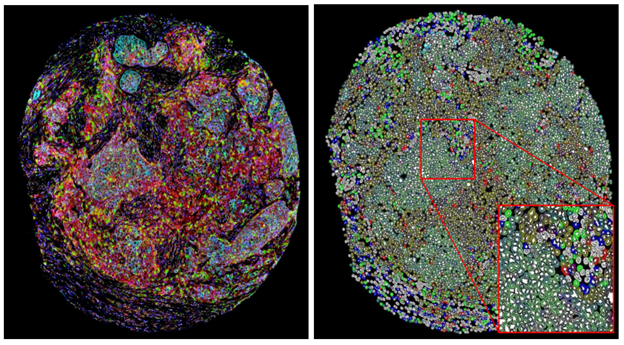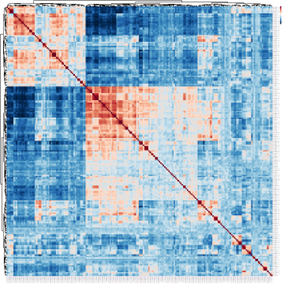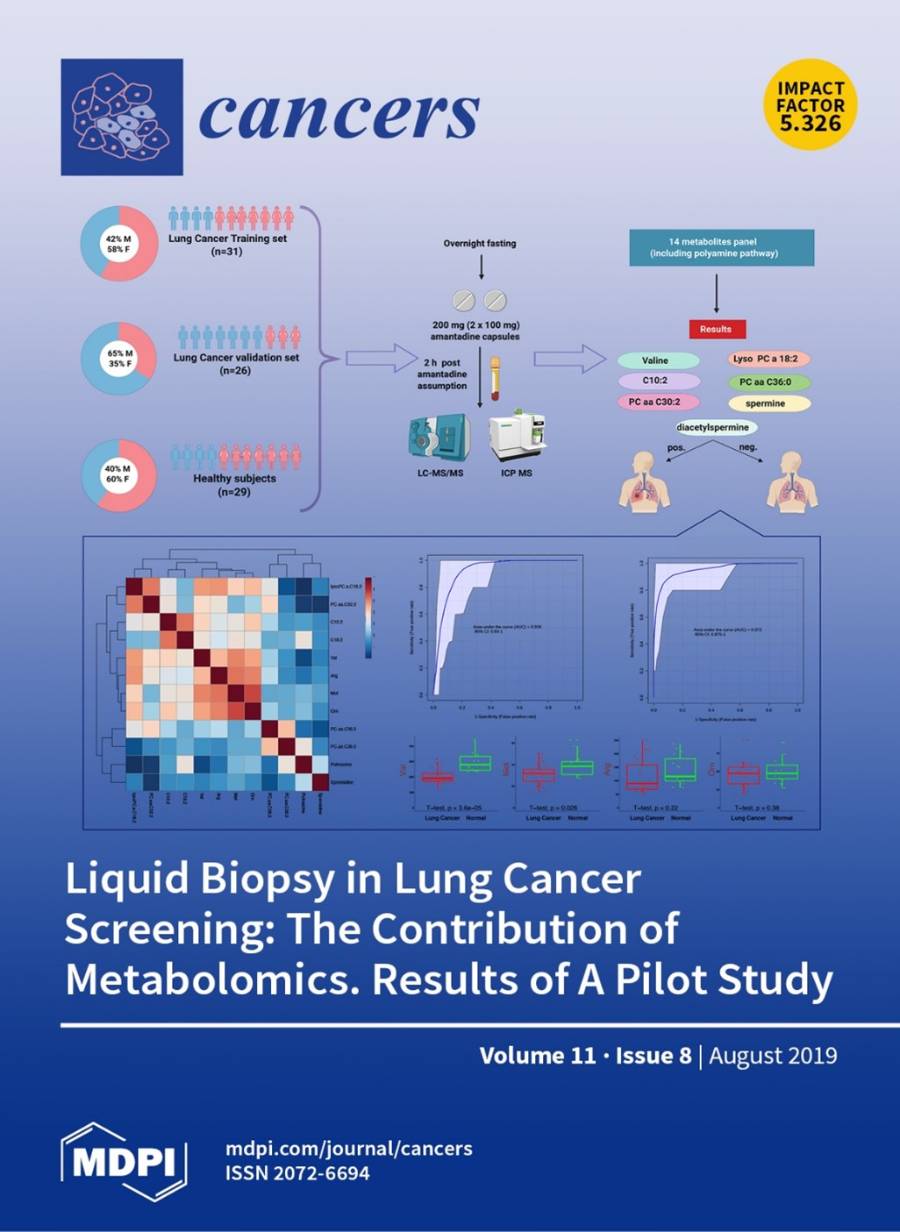Bioinformatics

- sandeep.singhal@UND.edu
- 701.777.0389
-
School of Medicine & Health Sciences Suite W415
Grand Forks ND 58202-9037
Current Projects
Dr. Singhal’s Lab has an integrated focus on to understand fundamental mechanisms of chromatin-based transcriptional control and epigenetic regulation with an emphasis on the role of metabolic imbalance in regulating these pathways in breast cancer. Major goals include understanding the role of metabolism and transcriptional cross-talk between epigenetic co-regulators and hormone receptor-mediated signaling pathways in both enhancer function and promoter-targeted mechanisms of gene control. An essential component of this work involves developing omics perspectives that will integrate next-generation sequencing with genomics, transcriptomics, epigenomics, proteomics metabolomics together with clinical-pathological conditions using model systems and patient-derived samples.

The use of digital pathology for the histomorphology profiling of pathological specimens is expanding the precision and specificity of quantitative tissue analysis at an unprecedented scale; thus, enabling the discovery of new and functionally relevant histological features of both predictive and prognostic significance. In this study, we apply quantitative automated image processing and computational methods to profile the subcellular distribution of the multi-functional transcriptional regulator, Kaiso (ZBTB33), in the tumors of a large racially diverse breast cancer cohort from a designated health disparities region in the United States.
This study identified a list of genes and pathways differently significantly changed after the arsenic exposure in humans and its association with cancer biology. We developed bladder cancer risk predictive models that would be very helpful to forecast the outcomes of arsenic exposed in humans.
https://ascopubs.org/doi/abs/10.1200/JCO.2021.39.15_suppl.e16523
Role of HRTPT in kidney proximal epithelial cell regeneration: Integrative differential expression and pathway analysis using microarray and scRNA-seq
Damage to proximal tubules due to exposure to toxicants can lead to conditions such as acute kidney injury (AKI), chronic kidney disease (CKD), and ultimately end-stage renal failure (ESRF). Studies have shown that kidney proximal epithelial cells can regenerate particularly after acute injury. The goal of this study is to characterize and understand the global gene expression differences, upregulated pathways as well as gene interaction using scRNA-seq in HRTPT cells.
https://pubmed.ncbi.nlm.nih.gov/34626063/

Gene expression data distribution
In this study, we found gp78/AMFR is an independent predictor of breast cancer survival and response to therapy, based on race, thus implicating a role for this protein, and potentially the UPR, as underlying biological differences in tumor properties linked to genetic ancestry.
https://ascopubs.org/doi/abs/10.1200/JCO.2021.39.15_suppl.553
The goal of the study is to characterize the somatic mutation profile of early-onset tumors from Puerto Ricans, a Hispanic subpopulation with a high CRC burden, in order to better understand early-onset CRC biology.
In this project, we are developing a novel application of persistent homology to characterize the spatial arrangement of immune and epithelial (tumor) cells within the breast cancer immune microenvironment.
https://drops.dagstuhl.de/opus/volltexte/2020/12169/pdf/LIPIcs-SoCG-2020-11.pdf

Microscopic image of a stained tissue sample.
Different subtypes of lung cancer respond differently to treatment. To understand the signaling pathways that dictate the aggressive behavior of lung adenocarcinoma vs. lung squamous cell carcinoma, we performed a survival analysis that demonstrated that the protein Schlafen 12 correlates with better survival in patients with lung adenocarcinoma but not patients with lung squamous cell carcinoma, indicating specificity of the effect of the SLFN12 pathway in lung cancer subtypes.
The BARDA Community Challenge is sponsored by Biomedical Advanced Research and Development Authority (BARDA) in partnership with the National Institute of Health’s National Center for Advancing Translational Sciences (NCATS), the Eunice Kennedy Shriver National Institute of Child Health and Human Development (NICHD) at the National Institutes of Health and Health Resources & Services Administration (HRSA) Maternal & Child Health Bureau.
We are analyzing the Gene expression data from blood to identify potential biomarkers that may be useful for distinguishing between Mild cognitive impairment (MCI) and Alzheimer’s disease dementia compared to normal people. We have developed a large dataset and are working on model development.

We are developing a Health Intelligence platform that delivers an all-in-one personalized health guide by interpreting human genetic, metabolite, protein and microbial molecular profiles and providing a tailored health action plan. The tool provides predictive and prescriptive health insights and personalized action plans based on human molecular profile. This is a monitoring tool for individuals where suggestions for nutrition, supplements, exercise, medication, stress reduction and rest are itemized that can improve their health over time.
Active Grants
Supplement to ND INBRE: Health and the Environment
A major contributor to health inequities is the lack of a diverse biomedical research workforce that is technically proficient in data management, computer programming, and analytics as well as the ability to work effectively on interdisciplinary teams.
DaCCoTA Scholar Project NIH
Artificial Intelligence to Correlate Proteomic and Genomic Data Together with Clinicopathologic and Demographic Attributes to Predict Breast Cancer Outcome.
The major goals of this project are to identify the differential role of a novel shortlisted set of “master transcriptional regulators” as drivers and prognostic predictors of breast cancer survival.
IDeA Networks of Biomedical Research Excellence (INBRE)
The major goal of this project is priming the pipeline of the next generation of health professionals and researchers by providing a summer undergraduate research program to students within the North Dakota University System (NDUS), TCUs, and private colleges and universities.
Postdoctoral Seed Funding Program
Contributing to the NSF-Supported Project (since 2019)
Project Title: MRI: Acquisition of Flash TAIL - An All-NVMe Flash Storage Instrument for the Talon Artificial Intelligence & Machine Learning Cloud.
Google Cloud Platform Award for COVID-19 Project
Students

-
Lt Nathan A. Ruprecht earned his Bachelor of Science and Master of Science in Electrical Engineering from the University of North Texas in 2017 and 2018 respectively, and currently working on his PhD in Biomedical Engineering at the University of North Dakota. He leveraged his education while at Holloman Air Force Base (AFB) a Navigation Systems Analyst with the 746 Test Squadron (TS) serving as a subject matter expert to translate program requirements in developmental and operational test and evaluation events. Lt Ruprecht was responsible for designing and executing methodologies to test inertial and GPS guided systems directing operations for lab, ground, and flight tests of land, sea, and air systems across the Department of Defense (DoD). He is currently the lead engineer for nuclear materials systems engineering at the Air Force Technical Application Center (AFTAC) at Patrick Space Force Base (SFB) where he is translating program requirements and overseeing technical progress across the acquisition lifecycle. His expertise resides in statistical modelling and machine learning for a slew of applications, primarily used in research interests such as bioinformatics and multiomic studies.
-
Education
- PhD Student, Biomedical Engineering, University of North Dakota.
- Master of Science in Electrical Engineering, University of North Texas, 2018.
- Bachelor of Science in Electrical Engineering, University of North Texas, 2017.
Publications/Posters
- Ruprecht, N.A. et al., Ongoing Results: Multiomics use on Radiation-Age Association for Space Exploration and Occupational Health. Poster Session. Fourth North Dakota Biomedical Engineering Symposium, 2021.
- Ruprecht, N. A., & Li, X. (2019). Implementation of compressive sampling for wireless sensor network applications. International Journal of Sensor Networks, 31(4), 226-237.

-
Jappreet S. Gill earned his Bachelor’s in Business Administration and a Post-graduate diploma in Computer Applications from Panjab University, Chandigarh, India. He completed his Master of Science in Information Systems from the California State University, Fullerton and is currently pursuing a PhD in Biomedical Engineering at the University of North Dakota. He is working in Dr. Sandeep’s lab with a focus on admixture analysis and ancestry estimation. He also works in research related to personalized medicine and cancer genomics. His area of expertise includes data mining and visualization, business analytics, statistical modeling, and artificial intelligence. His past research experience involves natural language processing, wireless communication, cybersecurity, simulations, and autonomous systems. While pursuing his Master, Jappreet has also gained industrial experience by working as a Data Analyst Intern at Inscopix Inc. to deliver actionable insights to the neurotechnology company known for transforming real-time brain mapping with its miniature microscope invention, by gathering, organizing, and interpreting complex datasets.
-
Education
- PhD Student, Biomedical Engineering, University of North Dakota.
- Master of Science (Information Systems), California State University, Fullerton, 2020.
- Post Graduate Diploma in Computer Applications, Panjab University, Chandigarh, India, 2017.
- Bachelor’s in Business Administration, Panjab University, Chandigarh, India, 2016.
Publications/Posters
- Jappreet Singh Gill & S Singhal, Ph.D., Admixture Estimation Using Deep Learning. Poster Session. Fourth North Dakota Biomedical Engineering Symposium, 2021.
- Gill, J. S., Velashani, M. S., Wolf, J., Kenney, J., Manesh, M. R., & Kaabouch, N. (2021, May). Simulation Testbeds and Frameworks for UAV Performance Evaluation. In 2021 IEEE International Conference on Electro Information Technology (EIT) (pp. 335-341). IEEE.

Andrea De La Mora
-
Andrea De La Mora earned her Bachelor of Science and Master of Science in Industrial and Systems Engineering and Modeling and Simulation Engineering in 2005 and 2020 respectively, and currently working on her PhD in Biomedical Engineering at the University of North Dakota. Andrea has worked 10 years in business analytics and currently leveraging this experience and applying it to Omics Data Analysis. Her goal is to develop mathematical-computational models to further the understanding of processes involved in mental disorders, cancers, and/or rare diseases. She has particular interest in understanding the process in which cells make proteins and investigating the interactions among the components of this process.
-
Education
- PhD student, Biomedical Engineering, University of North Dakota
- Master of Science (Modeling and Simulation Engineering), Old Dominion University, 2020.
- Bachelor of Science (Industrial and Systems Engineering), Universidad Autonoma del Pacifico Mexico, 2005

Benu Bansal
-
Benu Bansal earned her Bachelor of Engineering in Computer Science from Chitkara University, India in 2018 and a Master of Science in Information Systems from the California State University, Fullerton in 2020, and currently working on her PhD in Biomedical Engineering at the University of North Dakota. While pursuing her bachelor’s, she worked as a full-time Research Assistant Intern in the Research and Innovation network department at Chitkara University, India, for a year where she worked on various machine learning and artificial intelligence projects. Her past research experience involves natural language processing, location-based services and wireless computing. Her previous area of interest includes Data Mining, Machine Learning, Business Analytics and Mobile/Wireless computing. Her current area of research is focused on digital pathology in the tumor microenvironment in Dr. Singhal’s lab.
-
Education
- PhD Student, Biomedical Engineering, University of North Dakota.
- Master of Science in Information Systems (Business Analytics), California State University, Fullerton, 2020.
- Bachelor of Engineering (Computer Science), Chitkara University, India, 2018.
Publications/Posters
- Benu Bansal & S Singhal, Ph.D., Digital Histopathology of the Tumor Microenvironment. Poster Session. Fourth North Dakota Biomedical Engineering Symposium, 2021.
- (Best Paper Award) Benu Bansal, Wen-Chen Hu, and Naima Kaabouch. Detecting mobile pandemic misinformation by using mobile text/data mining. In Proceedings of the 25th World Multi-Conference on Systemics, Cybernetics and Informatics (WMSCI 2021), Orlando, Florida, USA, July 18-21, 2021.
- Wen-Chen Hu, Benu Bansal, and Naima Kaabouch. Opportunities and challenges from the milestones of information technology (IT). To appear in Journal Systemics, Cybernetics and Informatics (JSCI).
- Wen-Chen Hu, Benu Bansal, and Naima Kaabouch. Contemporary issues in the interdisciplinary research: smartphone computing research. Journal Systemics, Cybernetics and Informatics (JSCI), 18(7):110-117, 2020.
- Wen-Chen Hu, Benu Bansal, and Naima Kaabouch. Using incremental direction searches to stay away from COVID-19. Journal Systemics, Cybernetics and Informatics (JSCI), 18(6):89-94, 2020.
- Wen-Chen Hu, Benu Bansal, and Naima Kaabouch. Using mobile and wireless computing to facilitate virtual collaboration during a pandemic, Journal Systemics, Cybernetics and Informatics (JSCI), 18(1):273-288, 2020.

Kalli Schaefer
-
Kalli Schaefer earned her Bachelor of Biomedical Engineering from the University of Minnesota - Twin Cities in 2021 with an emphasis in Cell and Tissue Engineering. She is currently pursuing a Master of Science in Biomedical Engineering at the University of North Dakota. Her current research interests involve using bioinformatics to study breast cancer. Her past research experiences have included work in hematology, pain medicine, aging, and diabetes. During her time as an undergraduate, Kalli studied senolytics and aging as a part of the Mayo Clinic's Summer Undergraduate Research Fellowship program. In addition, during her undergraduate education, Kalli worked at the University of Minnesota Medical School's Schulze Diabetes Institute where she supported diabetic transplantation research.
-
Education
- Master’s Student, Biomedical Engineering, University of North Dakota.
- Bachelor of Biomedical Engineering, University of Minnesota, 2021.
Publications
- Schaefer & S Singhal, Ph.D., Androgen Receptor Expression in Triple Negative Breast Cancer. Poster Session. Fourth North Dakota Biomedical Engineering Symposium, 2021.
- Schaefer et al., Analysis of Tissues in Dose Escalation Study of Senolytics in Non-Human Primates. Poster Session. Mayo Clinic Graduate School of Biomedical Sciences Summer Student Symposium, 2019.
- Hickson, L. J., Prata, L. G. L., Bobart, S. A., Evans, T. K., Giorgadze, N., Hashmi, S. K., ... & Kirkland, J. L. (2019). Senolytics decrease senescent cells in humans: Preliminary report from a clinical trial of Dasatinib plus Quercetin in individuals with diabetic kidney disease. EBioMedicine, 47, 446-456. Print.
- Warner, Nafisseh S et al. “Peripheral Nerve Stimulation and Clinical Outcomes: A Retrospective Case Series.” Pain practice 21.4 (2021): 411–418. Web.
- Warner, Matthew A et al. “Improvements in Red Blood Cell Transfusion Utilization Following Implementation of a Single‐unit Default for Electronic Ordering.” Transfusion (Philadelphia, Pa.) 59.7 (2019): 2218–2222. Web.
- D'Souza RS, Warner MA, Olatoye OO, Langford BJ, Bruns DL, Schroeder DR, Mauck WD, Schaefer KK, Warner NS. Perioperative Opioid Consumption and Clinical Outcomes in Surgical Patients with a Pre-existing Opioid-Based Intrathecal Drug Delivery System. Anesth Analg. 2021 Jul 14. doi: 10.1213/ANE.0000000000005662. Epub ahead of print. PMID: 34260427.
Improvements in Red Blood Cell won "Top Rated Abstract" at the Mayo Clinic Quality Conference in 2019.
Past Projects
While maps allow us to follow the coronavirus in near real time, federal and local officials who manage COVID-19 response actions are also looking into projections about how the virus might behave in the future.
“Adams and Singhal are cooperating with the epidemiology group within the Department of Health, who have met with Doctor Anthony Fauci, who leads the National Institute of Allergy and Infectious Diseases and serves on the administration’s coronavirus taskforce, and Doctor Deborah Birx, response coordinator for the White House. At that meeting, Dr. Birx outlined coronavirus predictions for North Dakota that aligned well with Adams’ model”
https://blogs.und.edu/und-today/2020/04/und-researchers-track-map-model-the-pandemic/

The analysis also charts a comparison between North Dakota and the rest of the USA population.
We determine the weather-related variables that are influencing mosquito populations. Using the information from the glms, we identify for each species, at what time points those significant variables are playing a role.
Lung cancer is the most common cause of cancer-related deaths worldwide. Early diagnosis is crucial to increase the curability chance of the patients. Low dose CT screening can reduce lung cancer mortality, but it is associated with several limitations. Metabolomics is a promising technique for cancer diagnosis due to its ability to provide chemical phenotyping data.
https://www.mdpi.com/2072-6694/11/8
Article published on the cover page of the Journal

Breast cancer is a complex disease whose classification has been significantly improved in recent years through the development of biomarkers. Currently, there are four clinically distinct breast cancer subtypes. These subtypes determine molecular classification, along with clinical factors such as age, stage at diagnosis and comorbidity, in assessing treatment options. However, significant disparity in clinical outcome still remains within each of these disease subtypes, calling for extensive and ongoing research in breast cancer biomarkers. This is particularly the case in the United States with regard to the Triple Negative Breast Cancer subtype that occurs with nearly two-fold higher frequency in women of African ancestry. A high immune signal has been linked with improved patient outcome in a variety of cancers, including subtypes of breast cancer. CD4+ T cells, specifically, are central components of the immune system.
Furthermore, I was involved in a clinical trial that involved a randomized trial between letrozole and a placebo and letrozole and everolimus. In this trial, I have examined PIK3CA genotype and a PIK3CA mutation-related gene signature. His results indicated that the PIK3CA-GS identified ER-positive BCs that benefit from the addition of everolimus to letrozole5.
In one of my most influential contributions, I have developed a state-of-the-art model that identifies novel biomarkers to predict the response of drugs after short-term treatment for breast cancer, which aims to investigate the association between chemotherapy response and gene expression modules and uncover key biological processes and pathways in breast cancer subtypes2.
I have also addressed young age adds extra biological complexity, which is independent of differences in breast cancer subtypes. This study provides significant scientific rationale to examine these findings in the clinical setting.
Following are some article which appeared in some of the most competitive and prestigious journals in the field
- Peer-reviewed article first-authored by Dr. Singhal, Kaiso (ZBTB33) subcellular partitioning functionally links LC3A/B, the tumor microenvironment, and breast cancer survival. Nature - Communications biology 4 (1), 1-132021
- Peer-reviewed article co-authored by Dr. Singhal, SK Singhal Trans-ancestry genome-wide association meta-analysis of prostate cancer identifies new susceptibility loci and informs genetic risk prediction. Nature genetics 53 (1), 65-75
- Peer-reviewed article co-authored by Dr. Singhal, Ancestry-dependent gene expression correlates with reprogramming to pluripotency and multiple dynamic biological processes. Sci Adv. 2020 Nov;6(47). doi: 10.1126/sciadv.abc3851. Print 2020 Nov. PubMed PMID: 33219026; PubMed Central PMCID: PMC7679169.
- Peer-reviewed article co-first-authored by Dr. Singhal, "Racial Differences in the Association between Luminal Master Regulator Expression and Breast Cancer Survival". Clinical Cancer Research, 2020
- Peer-reviewed article co-authored by Dr. Singhal, “CD4+ follicular helper T cell infiltration predicts breast cancer survival,” The Journal of Clinical Investigation, 2013 & a testimonial letter confirming Dr. Singhal’s substantial contribution
- Peer-reviewed article co-first-authored by Dr. Singhal, “Gene modules and response to neoadjuvant chemotherapy in breast cancer subtypes: a pooled analysis,” Journal of Clinical Oncology, 2012J Clin Oncol 30:1996-2004, 2012
- Peer-reviewed article co-first-authored by Dr. Singhal, “Low residual proliferation after short-term letrozole therapy is an early predictive marker of response in high proliferative ER-positive breast cancer,” Endocrine-Related Cancer, 2011Endocr Relat Cancer 18:721-30, 2011
- Peer-reviewed article co-authored by Dr. Singhal, “Elucidating prognosis and biology of breast cancer arising in young women using gene expression profiling,” Clinical Cancer Research, 2012
- Peer-reviewed article co-authored by Dr. Singhal, “PIK3CA Genotype and a PIK3CA Mutation-Related Gene Signature and Response to Everolimus and Letrozole in Estrogen Receptor Positive Breast Cancer,” PLoS One, 2013 PLoS One 8: e53292, 2013
In another contribution, I have demonstrated that understanding genetics and epigenetics is essential to improving the diagnosis and treatment. I found that DNA methylation profiling can reflect the cell type composition of the tumor microenvironment, and in particular a T lymphocyte infiltration of the tumors. Furthermore, I identified a set of immune genes having a high prognostic value in specific tumor categories. These immune components provide a new perspective regarding the microenvironment in breast cancer, which holds implications for better management of breast cancer patients. In a collaborative study with different labs, we have demonstrated that understanding of genetics with epigenetics is essential to improve diagnosis and optimizing treatment. We showed that DNA methylation profiling can reflect the cell type composition of the tumor microenvironment, and in particular a T lymphocyte infiltration of the tumors. We identified a set of immune genes having high prognostic value in specific tumor categories. The immune component uncovered here by DNA methylation profiles provides a new perspective for the importance of the microenvironment in breast cancer, holding implications for better management of breast cancer patients 1,2. This research is extremely useful and informative in minimizing the side effects of systemic therapy, which will overcome the existing limitations of toxic manifestation, often encountered in conventional therapeutic interventions, such as chemotherapy, endocrine or hormonal therapy.
- Peer-reviewed article co-authored by Dr. Singhal Epigenetic re-wiring of breast cancer by pharmacological targeting of C-terminal binding protein. Cell death & disease 10 (10), 1-15
- Peer-reviewed article co-authored by Dr. Singhal, “DNA methylation profiling reveals a predominant immune component in breast cancers,” EMBO Mol Med3:726-41, 2011
- Peer-reviewed article first-authored by Dr. Singhal, “Towards understanding the breast cancer epigenome: a comparison of genome-wide DNA methylation and gene expression data,” Oncotarget,Oncotarget 7:3002-17, 2016
Radiotherapy is a mainstay of cancer treatment, used in either a curative or palliative manner to treat approximately 50% of patients with cancer. But damage to surrounding normal tissues can produce reactions ranging from bothersome symptoms that negatively affect quality of life to severe life-threatening complications. Improved ways of predicting, before treatment, the risk for development of normal tissue toxicity may allow for more personalized treatment and reduce the incidence and severity of late effects1. Urethral strictures (US) is a rare complication of prostate cancer patients treated with brachytherapy (BXT). I have developed a risk prediction model to predict the radiation toxicity US after BXT using clinical, dose- parameters2. This modeling approach, which is novel in BXT, helped to identify a combination of parameters with some predictive ability of radiation toxicity. Another major toxicity after radiation therapy is rectal bleeding. I have developed a validated model to predict the risk of radiation proctitis using clinical, radiation dose symmetric and high-throughput genomic (GWAS) data. A gwas pipeline has been created to pool data from different studies developed by our collaborators from the United States, United Kingdom and Spain and then divided as training set to develop a model and test dataset to evaluate its prediction ability. All patients were treated with External beam radiotherapy (EBRT) & brachytherapy. In a large collaborative study, we identified a refined set of candidate variants substantially increasing the proportion of familial relative risk explained by these known susceptibility regions, which highlights the importance of fine-mapping studies and has implications for clinical risk profiling3,4.
- Peer-reviewed article co-authored by Dr. Singhal, “The Prediction of Radiotherapy Toxicity Using Single Nucleotide Polymorphism-Based Models: A Step Toward Prevention,” Seminars in Radiation Oncology, 2015
- Peer-reviewed article first-authored by Dr. Singhal, “Clinical factors and dosimetry associated with development of prostate brachytherapy-related urethral strictures: A matched case-control study,” Brachytherapy, 2017
- Peer-reviewed article co-authored by Dr. Singhal, “Association analyses of more than 140,000 men identify 63 new prostate cancer susceptibility loci,” Nature Genetics, 2018
- Peer-reviewed article co-authored by Dr. Singhal, “Fine-mapping of prostate cancer susceptibility loci in a large meta-analysis identifies candidate causal variants,” Nature Communications, 2018
Affiliations
- Columbia University Medical Center, New York, NY 10032, USA
- Marlene and Stewart Greenebaum Comprehensive Cancer Centre, University of Maryland, Baltimore, MD 21201, USA
- Cancer Care Manitoba, Winnipeg, MB R3E 0V9, Canada
- Department of Internal Medicine, Rady Faculty of Health Sciences, University of Manitoba, Winnipeg, MB R3A 1R9, Canada
- Asper Clinical Research Institute & Office of Clinical Research, St. Boniface Hospital, Winnipeg, MB R2H 2A6, Canada
- Department of Pharmacology & Therapeutics, Rady Faculty of Health Sciences, University of Manitoba, Winnipeg, MB R3E 0T5, Canada
- Medical Oncology Unit A.O. Papardo & Department of Human Pathology, University of Messina, 98158 Messina, Italy
- Department of Medical Oncology, National Institute of Cancer Research & Hospital, Mohakhali, 1221 Dhaka, Bangladesh
- FastBios, House 12, Rd 14/C, Sector 4, Uttara, 1230 Dhaka, Bangladesh
- BioMark Diagnostics Inc., Richmond, BC V6X 2W8, Canada